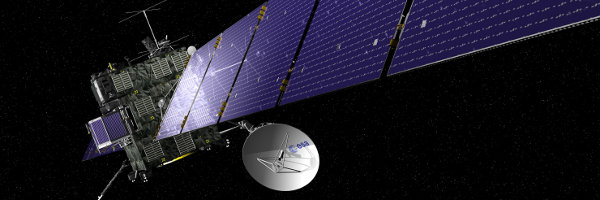
Rosetta: A Journey to Comet Churyumov-Gerasimenko
Rosetta is a mission of the European Space Agency (ESA) to comet 67P/Churyumov-Gerasimenko. The Rosetta orbiter was launched on 2 March 2004 to its 10-year journey to the comet. The spacecraft could not reach its destination on a direct path: Rosetta flew by Mars once and three times by Earth. Only after these multiple swing-bys, it had sufficient energy to reach the targeted comet.
On 6 August 2014 Rosetta reached the orbit of its comet nucleus and, thus, became the first man-made satellite of a comet. From an initial distance of 100km its orbit was lowered to a distance of 10 km until mid-October 2014. Thereby, the comet nucleus was studied at close proximity and a suitable landing site for the lander Philae was sought.
On 12 November 2014 Philae was released from Rosetta and reached the cometary surface after seven hours of descent. Philae is the first lander that has ever landed on a comet nucleus.
The Rosetta orbiter is equipped with eleven scientific instruments. The MPS leads the operation of the scientific camera system OSIRIS and the mass spectrometer COSIMA. Furthermore, the institute is involved in the instruments MIRO, ROSINA and CONSERT. The lander Philae carries ten experiments for the investigation of the comet aboard. The MPS heads the gas analyzer COSAC and is involved in the instruments ROMAP, SESAME and CONSERT. In addition, the MPS contributed substantially to the development and manufacturing of Philae.
Since its arrival at the comet in August 2014, Rosetta follows the comet on its orbit around the Sun. Most of the time, the orbiter was at a distance between 30 and 100km from the comet nucleus. The instruments aboard permanently collect data of the nucleus as well as the emitted gas and dust in close proximity to the nucleus and send them back to Earth. The comet passed its perihelion in August 2015. At this time, the comet reached its highest activity, before moving away from the Sun again.
Comets are considered cosmic deep freezers. As they spend most of their lifetime far from the Sun in deep space, the conditions from the early times of our solar system are conserved within them. For the first time, Mission Rosetta offers the opportunity to investigate a comet, and thereby study original material from the formation phase of our solar system, at close proximity over a long period of time.